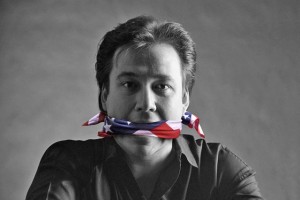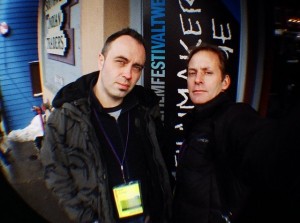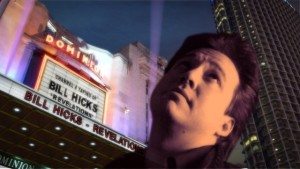 What’s that old saying about a prophet being despised in his homeland? Until his death in 1994, Bill Hicks was a cultural exile in the United States, a stand-up comedian both cerebral and visceral who poured fiery scorn on corruption and apathy, Reagan Republicans, and corporate whores like Jay Leno. For his effort, he was a cult performer, notoriously censored from The Late Show With David Letterman. But in Great Britain in the early 1990s, when the culturally literate stared in despair at the nation that gave the world the First Gulf War and Carrot Top, he was the best evidence for the defense. Hicks was the angry American whose fury was driven not by greed but by disappointment that things weren’t just better.
What’s that old saying about a prophet being despised in his homeland? Until his death in 1994, Bill Hicks was a cultural exile in the United States, a stand-up comedian both cerebral and visceral who poured fiery scorn on corruption and apathy, Reagan Republicans, and corporate whores like Jay Leno. For his effort, he was a cult performer, notoriously censored from The Late Show With David Letterman. But in Great Britain in the early 1990s, when the culturally literate stared in despair at the nation that gave the world the First Gulf War and Carrot Top, he was the best evidence for the defense. Hicks was the angry American whose fury was driven not by greed but by disappointment that things weren’t just better.
Matt Harlock, half of the team behind new documentary American: The Bill Hicks Story, explained, “I was one of the guys who was at university in the UK in the late Eighties, early Nineties, who was handed a sweaty and much-coveted bootleg” of Hicks’ work. For co-director/producer Paul Thomas, the interest was much more professional. Harlock explained, “His job for [Welsh TV broadcasters] HTV and the BBC was to find and bring on new comedians, so he came upon [Hicks] that way.”
Bill Hicks spent more than half of his far too short life of 32 years as the comedian’s comedian, performing his incendiary stand-up in what he dubbed his ‘flying saucer tour’ – “which means,” he would tell audiences, “like UFOs, I too have been appearing in small Southern towns in front of a handful of hillbillies.” At the same time he was selling out theatres in Britain and Canada. In 2004, the British House of Commons tabled an early day motion – the equivalent of a legislative resolution – marking the 10th anniversary of the passing of “one of the few people who may be mentioned as being worthy of inclusion with Lenny Bruce in any list of unflinching and painfully honest political philosophers.” Three years later, Britain’s Channel 4 TV station polled 150,000 viewers to find the 100 greatest comedians of all time. Harlock recalled: “Bill was number six. The Top 5 were people who were all alive and working in the UK.”

When he and Thomas finally met, Harlock said: “We realized that there had never really been a complete retelling of Bill’s story. … We wanted something that got a little more into his family relationships and his motivations.” American catches his astonishing ascent – from precociously self-assured high school comic in Houston to holding a packed house at London’s Dominion Theatre in the palm of his hand for his incendiary Revelations TV special. Yet it’s not just about the best jokes. Even as a longtime fan, Harlock said: “I’d never seen the whole arc of his comedy laid out in one chronological arc. … We really wanted to break away from the sort of ‘best of’ approach.”
Before production started, Harlock got to know Hicks’ family and his oldest friends through arranging charity tribute nights in the UK, and they allowed him to screen previously unseen footage at those events. The family had not spoken publicly about Bill since 1994’s It’s Just a Ride tribute special, and while Harlock knew they were besieged by businesses hoping to cash in on his reputation, he found them very open to working on a documentary. There was, he said, “a realization on their part that none of them, particularly Bill’s mum, was getting any younger and this may be the last chance they would have to put this stuff down on the historical record.” (Bill’s father died shortly before filming began.) Spending several days with each interviewee helped shape the direction of the movie beyond simple biographical reminiscences. Harlock said, “These people who knew him, his lifelong friends and his family, all seemed to have a very incisive view about what he was doing in his life at that time and how it affected what he was doing on stage.” Those same friends and family also gave the filmmakers access to a remarkable archive of footage and photographs, much of it collected by Bill Hicks himself. Harlock said: “Bill was quite an obsessive, in terms of cataloging and keeping programs and photographs of himself. Very often, when he worked with photographers, he wouldn’t just take the print but the contact sheet as well.” That kind of self-memorializing is something that he said he has heard other documentarians discuss happens with subjects with a strong voice or viewpoint. “It’s not that they’re arrogant,” he said. “It’s just that they’re aware that they’re doing something which is of interest.”
Sitting on a huge pile of previously unseen material and inspired by some of the experiments in 2002’s visually groundbreaking documentary The Kid Stays in the Picture, Harlock said they decided to “repurpose” the photographs through animation. Combining the audio of the now aging interviewees with new moving images of them in their youth would, Harlock hoped, “give the viewer a more immersive view of what was going on.” It also allowed the filmmakers to virtually re-enact some famous parts of Hicks folklore, like the first time he took mushrooms or when he and his underage friends broke curfew to go to their first comedy club. Harlock said, “We thought the best way to re-create the feeling of these three kids sneaking out on this commando mission would be to shoot it like you would a drama.” The visuals were created by melding old photos, body doubles, and location shots to create fluid composites. So as not to take too much license, he said, “we had quite strict rules for ourselves about making it authentic. So in that scene, we went to Bill’s real childhood home, and we talked our way in using our English accents. We put on sort of a lost Hugh Grant, ‘Oh, I don’t know what I’m doing,’ and people don’t seem to mind.”
 What he and Thomas discovered in the edit was the evolution of Hicks’ work as each pivotal personal event – his first professional gig, the substance use and abuse, cleaning up, moving from city to city – was reflected in his stand-up. “The archive material of Bill performing was directly informed by what was going on around his life,” said Harlock. “The comedy changed and became stronger and more focused when he stopped drinking and doing drugs.”
What he and Thomas discovered in the edit was the evolution of Hicks’ work as each pivotal personal event – his first professional gig, the substance use and abuse, cleaning up, moving from city to city – was reflected in his stand-up. “The archive material of Bill performing was directly informed by what was going on around his life,” said Harlock. “The comedy changed and became stronger and more focused when he stopped drinking and doing drugs.”
Even as self-confessed Hicks fans, Harlock said: “One of the things we were most surprised by was how precociously talented he was at that young age. That first clip of him, it’s not just funny, it’s really well-crafted. He’d have this wonderful goofy setup and draw you away from the punch line, then just bring you back with a tag. It’s really sophisticated stuff for a kid who’s 16, 17.” Yet for all the youthful exuberance, there’s also the trauma of watching the last six months before pancreatic cancer killed him. Harlock said: “Up to June of ’93, when he was diagnosed, he was a big lad. He was 6 feet, 2 inches, and he was broad-shouldered, and then how much weight he lost, that was quite shocking to me. Yet his voice never changed. His audio recordings, like Rant in E-Minor or Arizona Bay, you never got the feeling of someone ill or depleted energy-wise.”
With fitting cultural symmetry, American has already had its world premiere, to standing ovation, at the London Film Festival. Now Harlock said he and Thomas were eager to bring the film to Texas and especially to Austin, where Hicks recorded his Sane Man video and which he called home for much of his final, most prolific years. Harlock explained: “The pull that we’ve seen in the UK has not been matched in the reaction we’ve seen in the States. Even amongst young people, or people of the right age, should I say, we’re still finding that the level of recognition was much lower than we would have hoped. Our job, as we see it, is the same as his was in his lifetime, and that’s to get his work and his words out to as many people as possible.”
(a version of this interview ran at Austinchronicle.com)